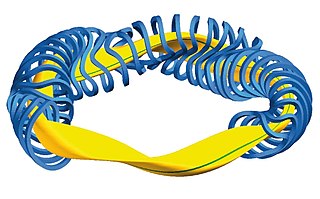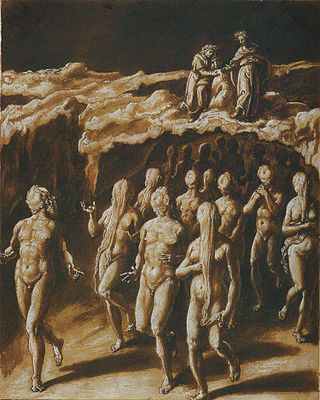Calculus, originally called infinitesimal calculus or "the calculus of infinitesimals", is the mathematical study of continuous change, in the same way that geometry is the study of shape, and algebra is the study of generalizations of arithmetic operations.
An imaginary number is a real number multiplied by the imaginary unit i, which is defined by its property i2 = −1. The square of an imaginary number bi is −b2. For example, 5i is an imaginary number, and its square is −25. By definition, zero is considered to be both real and imaginary.

Princeton University is a private research university in Princeton, New Jersey. Founded in 1746 in Elizabeth as the College of New Jersey, Princeton is the fourth-oldest institution of higher education in the United States and one of the nine colonial colleges chartered before the American Revolution. It is one of the highest-ranked universities in the world. The institution moved to Newark in 1747, and then to the current site nine years later. It officially became a university in 1896 and was subsequently renamed Princeton University. It is a member of the Ivy League.

A stellarator is a plasma device that relies primarily on external magnets to confine a plasma. Scientists researching magnetic confinement fusion aim to use stellarator devices as a vessel for nuclear fusion reactions. The name refers to the possibility of harnessing the power source of the stars, such as the Sun. It is one of the earliest fusion power devices, along with the z-pinch and magnetic mirror.

In mathematics, non-Euclidean geometry consists of two geometries based on axioms closely related to those that specify Euclidean geometry. As Euclidean geometry lies at the intersection of metric geometry and affine geometry, non-Euclidean geometry arises by either replacing the parallel postulate with an alternative, or relaxing the metric requirement. In the former case, one obtains hyperbolic geometry and elliptic geometry, the traditional non-Euclidean geometries. When the metric requirement is relaxed, then there are affine planes associated with the planar algebras, which give rise to kinematic geometries that have also been called non-Euclidean geometry.
In mathematics, certain kinds of mistaken proof are often exhibited, and sometimes collected, as illustrations of a concept called mathematical fallacy. There is a distinction between a simple mistake and a mathematical fallacy in a proof, in that a mistake in a proof leads to an invalid proof while in the best-known examples of mathematical fallacies there is some element of concealment or deception in the presentation of the proof.
A rhyme scheme is the pattern of rhymes at the end of each line of a poem or song. It is usually referred to by using letters to indicate which lines rhyme; lines designated with the same letter all rhyme with each other.
In music, transposition refers to the process or operation of moving a collection of notes up or down in pitch by a constant interval.
The shifting of a melody, a harmonic progression or an entire musical piece to another key, while maintaining the same tone structure, i.e. the same succession of whole tones and semitones and remaining melodic intervals.
Scansion, or a system of scansion, is the method or practice of determining and (usually) graphically representing the metrical pattern of a line of verse. In classical poetry, these patterns are quantitative based on the different lengths of each syllable. In English poetry, they are based on the different levels of stress placed on each syllable. In both cases, the meter often has a regular foot. Over the years, many systems have been established to mark the scansion of a poem.

A décima is a ten-line stanza of poetry. The most popular form is called décima espinela after Vicente Espinel (1550–1624), a Spanish writer, poet, and musician from the Siglo de Oro who used it extensively throughout his compositions.

Xuanhanosaurus is a genus of theropod dinosaur that lived during the Middle Jurassic of China, around 167.7 to 161.2 million years ago.

In Dante's Inferno, contrapasso is the punishment of souls "by a process either resembling or contrasting with the sin itself." A similar process occurs in the Purgatorio.

"Sonnet 18" is one of the best-known of the 154 sonnets written by the English playwright and poet William Shakespeare.

Liaoningopterus, sometimes misspelled as "Liaoningopteryx", was a genus of anhanguerid pterodactyloid pterosaur from the Barremian-Aptian-age Lower Cretaceous Jiufotang Formation of Chaoyang, Liaoning, China.

Maniraptoriformes is a clade of dinosaurs with pennaceous feathers and wings that contains ornithomimosaurs and maniraptorans. This group was named by Thomas Holtz, who defined it as "the most recent common ancestor of Ornithomimus and birds, and all descendants of that common ancestor."

Infinity is that which is boundless, endless, or larger than any natural number. It is often denoted by the infinity symbol .

Linhenykus is an extinct genus of alvarezsaurid theropod dinosaur from the Late Cretaceous of Inner Mongolia, China. It is the most basal known member of the Parvicursorinae. The genus gets its name from Linhe, a city near the site where the fossil was first found and Greek nykus, "claw". The specific name is derived from Greek monos, "single", and daktylos, "finger", a reference to the fact that it is the only known non-avian dinosaur to have had but a single digit.

Hanosaurus is an extinct genus of marine reptiles that existed during the Triassic period in what is now China. It was described by Young in 1972, and the type species is Hanosaurus hupehensis. Its affinities are unclear; it has been both described as a member of the Pachypleurosauria and as a sister group of that group. It was a small animal, measuring 70–79.4 cm (27.6–31.3 in) long and weighing 1 kg (2.2 lb), which likely fed on soft-bodied prey.
The 1980 Princeton Tigers football team was an American football team that represented Princeton University during the 1980 NCAA Division I-A football season. Princeton tied for third in the Ivy League.
The 1995 Dartmouth Big Green football team was an American football team that represented Dartmouth College during the 1995 NCAA Division I-AA football season. Dartmouth finished fourth in the Ivy League.











